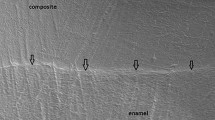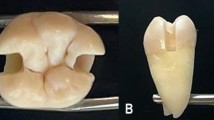Abstract
The aim was to evaluate the marginal-gap formation and curing profile of a new restorative technique using a liner with long-wavelength-absorbing photoinitiator (LWAP). Box-shaped preparations (6 mm × 4 mm × 4 mm) were made in third molars. All samples were treated with Clearfill SE Bond and divided into 4 groups (n = 5), according to restorative technique used: (1) incremental technique (INC-Technique); (2) camphorquinone-based liner (CQ-Liner) + bulk-fill resin composite; (3) LWAP-based liner (LWAP-Liner) + bulk-fill resin composite; and (4) bulk-fill technique without liner (BF-Technique). The marginal gaps (%) for all the samples were measured using micro-computed tomography. The restorations were cross-sectioned, and the degree of conversion (DC) and Knoop microhardness were evaluated at different depths (0.3, 1, 2, 3, and 4 mm). INC-Technique, CQ-Liner, and LWAP-Liner groups showed significantly fewer marginal gaps than those from the BF-Technique group. The BF-Technique specimens had the lowest DC and microhardness in depth. All the other techniques presented similar degree of conversion and microhardness at all the depths. The use of liners, regardless of the photoinitiator system, decreased the marginal-gap formation and improved the curing profile of bulk-filling restoration technique.





Similar content being viewed by others
Data Availability
The data used to support the findings of this study are available from the corresponding author upon request.
References
El-Damanhoury H, Platt J (2014) Polymerization shrinkage stress kinetics and related properties of bulk-fill resin composites. Oper Dent 39(4):374–382. https://doi.org/10.2341/13-017-L
Santini A, Gallegos IT, Felix CM (2013) Photoinitiators in dentistry: a review. Prim Dent J 2(4):30–33. https://doi.org/10.1308/205016814809859563
Vaidyanathan TK, Vaidyanathan J, Lizymol PP, Ariya S, Krishnan KV (2017) Study of visible light activated polymerization in BisGMA-TEGDMA monomers with type 1 and type 2 photoinitiators using Raman spectroscopy. Dent Mater 33(1):1–11. https://doi.org/10.1016/j.dental.2016.09.002
Rocha MG, de Oliveira D, Sinhoreti M, Roulet JF, Correr AB (2019) The combination of CQ-amine and TPO increases the polymerization shrinkage stress and does not improve the depth of cure of bulk-fill composites. Oper Dent 44(5):499–509. https://doi.org/10.2341/18-234-L
Yeh CL, Powers JM, Miyagawa Y (1982) Color of selected shades of composites by reflection spectrophotometry. J Dent Res 61(10):1176–1179. https://doi.org/10.1177/00220345820610101401
Oliveira DCRS, Rocha MG, Correr AB, Silvino A, Sinhoreti MAC (2017) From blue to red: new photoinitiator systems for dental materials. Dent Mater 33:88–89. https://doi.org/10.1016/j.dental.2017.08.177
Harlow JE, Rueggeberg FA, Labrie D, Sullivan B, Price RB (2016) Transmission of violet and blue light through conventional (layered) and bulk cured resin-based composites. J Dent 53:44–50. https://doi.org/10.1016/j.jdent.2016.06.007
O’Shaughnessy B, Yu J (1994) Autoacceleration in free radical polymerization. 1 Conversion. Macromolecules 27(18):5067–5078. https://doi.org/10.1021/ma00096a032
Almeida Junior LJS, Penha Karla JS, Souza AF, Lula ECO, Magalhães FC, Lima DM, Martins D, Firoozmand LM (2017) Is there correlation between polymerization shrinkage, gap formation, and void in bulk fill composites? A μCT study Braz Oral Res 31:100. https://doi.org/10.1590/1807-3107bor-2017.vol31.0100
Han SH, Sadr A, Tagami J, Park SH (2016) Non-destructive evaluation of an internal adaptation of resin composite restoration with swept-source optical coherence tomography and micro-CT. Dent Mater 32(1):e1-7. https://doi.org/10.1016/j.dental.2015.10.009
Oglakci B, Kazak M, Donmez N, Dalkilic EE, Koymen SS (2019) The use of a liner under different bulk-fill resin composites: 3D GAP formation analysis by x-ray microcomputed tomography. J Appl Oral Sci 28:e20190042. https://doi.org/10.1590/1678-7757-2019-0042
Firla MT (2015) Seventeen years of using flowable resin restoratives-a dental Practitioner’s personal Clinical Review. Dent Update 42(3):261-4–267-8. https://doi.org/10.12968/denu.2015.42.3.261
Silame FDJ, Geraldeli GP, Sinhoreti MAC, Pires-de-Souza FCP, Roulet JF, Geraldeli S (2017) Dentin µTBS and hardness of bulk-fill and conventional composites placed in a box-shaped cavity preparation. J Adhes Dent 19(5):395–400. https://doi.org/10.3290/j.jad.a39276
Han SH, Sadr A, Tagami J, Park SH (2016) Internal adaptation of resin composites at two configurations: influence of polymerization shrinkage and stress. Dent Mater 32(9):1085–1094. https://doi.org/10.1016/j.dental.2016.06.005
Yushkevich PA, Piven J, Hazlett HC, Smith RG, Ho S, Gee JC, Gerig G (2006) User-guided 3D active contour segmentation of anatomical structures: significantly improved efficiency and reliability. Neuroimage 31(3):1116–1128. https://doi.org/10.1016/j.neuroimage.2006.01.015
Yoshimine N, Shimada Y, Tagami J, Sadr A (2015) Interfacial adaptation of composite restorations before and after light curing: effects of adhesive and filling technique. J Adhes Dent 17(4):329–336. https://doi.org/10.3290/j.jad.a34554
Nie J, Yap AU, Wang XY (2018) Influence of shrinkage and viscosity of flowable composite liners on cervical microleakage of class II restorations: a micro-CT analysis. Oper Dent 43(6):656–664. https://doi.org/10.2341/17-091-L
Kaisarly D, Meierhofer D, El Gezawi M, Rösch P, Kunzelmann KH (2021) Effects of flowable liners on the shrinkage vectors of bulk-fill composites. Clin Oral Investig 25:4927–4940. https://doi.org/10.1007/s00784-021-03801-2
Cara RR, Fleming GJ, Palin WM, Walmsley AD, Burke FJ (2007) Cuspal deflection and microleakage in premolar teeth restored with resin-based composites with and without an intermediary flowable layer. J Dent 35(6):482–489. https://doi.org/10.1016/j.jdent.2007.01.005
Wang Z, Chiang MY (2016) Correlation between polymerization shrinkage stress and C-factor depends upon cavity compliance. Dent Mater 32(3):343–352. https://doi.org/10.1016/j.dental.2015.11.003
Münchow EA, Sedrez-Porto JA, Piva E, Pereira-Cenci T, Cenci MS (2016) Use of dental adhesives as modeler liquid of resin composites. Dent Mater 32(4):570–577. https://doi.org/10.1016/j.dental.2016.01.002
Chiang YC, Hickel R, Lin CP, Kunzelmann KH (2010) Shrinkage vector determination of dental composite by μCT images. Compos Sci Technol 70(6):989–994. https://doi.org/10.1016/j.compscitech.2010.02.017
Fronza BM, Rueggeberg FA, Braga RR, Mogilevych B, Soares LE, Martin AA, Ambrosano G, Giannini M (2015) Monomer conversion, microhardness, internal marginal adaptation, and shrinkage stress of bulk-fill resin composites. Dent Mater 31(12):1542–1551. https://doi.org/10.1016/j.dental.2015.10.001
Tjäderhane L (2015) Dentin bonding: can we make it last? Oper Dent 40(1):4–18. https://doi.org/10.2341/14-095-BL
Ilie N (2017) Impact of light transmittance mode on polymerisation kinetics in bulk-fill resin-based composites. J Dent 63:51–59. https://doi.org/10.1016/j.jdent.2017.05.017
Price RBT (2017) Light curing in dentistry. Dent Clin North Am 61(4):751–778. https://doi.org/10.1016/j.cden.2017.06.008
Holder MJ, Milward MR, Palin WM, Hadis MA, Cooper PR (2012) Effects of red light-emitting diode irradiation on dental pulp cells. J Dent Res 91(10):961–966. https://doi.org/10.1177/0022034512456040
Acknowledgements
The authors thank to the staff of the Laboratory of Soft Materials at the Brazilian Laboratory of Nanotechnology (LNNano – CNPEM) for X-ray micro-CT analysis and instrumentation and Coordination for the Improvement of Higher Education Personnel (CAPES) by the financial support (Code 001). We thank Ultradent for the donation of the flowable composite resin.
Author information
Authors and Affiliations
Contributions
Conceptualization: May Anny Alves Fraga, Dayane Carvalho Ramos Salles de Oliveira, Mateus Garcia Rocha, Américo Bortolazzo Correr. Methodology: May Anny Alves Fraga. Formal analysis and investigation: May Anny Alves Fraga. Writing — original draft preparation: May Anny Alves Fraga. Writing — review and editing: Dayane Carvalho Ramos Salles de Oliveira, Américo Bortolazzo Correr, Mário Alexandre Coelho Sinhoreti, Lourenço Correr-Sobrinho. Funding acquisition: Américo Bortolazzo Correr. Supervision: Américo Bortolazzo Correr.
Corresponding author
Ethics declarations
Conflict of interest
The authors declare no competing interests.
Additional information
Publisher's note
Springer Nature remains neutral with regard to jurisdictional claims in published maps and institutional affiliations.
Rights and permissions
Springer Nature or its licensor (e.g. a society or other partner) holds exclusive rights to this article under a publishing agreement with the author(s) or other rightsholder(s); author self-archiving of the accepted manuscript version of this article is solely governed by the terms of such publishing agreement and applicable law.
About this article
Cite this article
Fraga, M.A.A., de Oliveira, D.C.R.S., Rocha, M.G. et al. Curing profile and marginal gap formation using a liner containing long-wavelength-absorbing photoinitiator: an in vitro study. Lasers Med Sci 38, 69 (2023). https://doi.org/10.1007/s10103-023-03731-3
Received:
Accepted:
Published:
DOI: https://doi.org/10.1007/s10103-023-03731-3




